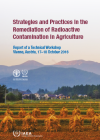Nuclear or radiological accidents can contaminate agricultural land and produce. Contaminants are substances not intentionally added to agricultural land and products, but present in or on them. They may include either stable or radioactive material and can originate from natural sources or as the result of human activities.
Assessment of contamination in agriculture
The release of radionuclides to the air, land and water and their transfer into the food chain, is a dynamic process and concentrations will vary over time and space across landscapes. To prepare for, respond to and manage emergencies, systems need to be in place to monitor, assess and visualize where agriculture is affected. Such systems must be implemented at the earliest opportunity in the event of an accident.
Together with the FAO, the IAEA focuses on systems and protocols with which the extent of contamination in agricultural production can be assessed. The goal of these activities is to mitigate the effects of radioactive contamination on food and agriculture and to strengthen radiation safety of the agricultural environment and of consumers. This in turns supports producers and trade, and therefore has an economic as well as a social dimension.
Systems to allow for swift decisions in emergencies
During emergencies, up-to-date information on the spatial and temporal distributions of radionuclides in the landscape is necessary for decision-makers and for public confidence. The challenge is to collect, monitor and make available information through efficient data collection, data management and spatial and temporal mapping of radionuclide concentrations in soil, water, plants and animals.
The systems and protocols developed by the IAEA and the FAO can be used for routine surveillance in everyday use. In an emergency, however, their aim is to optimize the response time of Member States, allowing them to decide rapidly on whether food restrictions are needed. The systems also provide simple procedures and protocols for collecting samples, managing large amounts of data, and to map and visualize affected areas for effective communication with the wider public.







